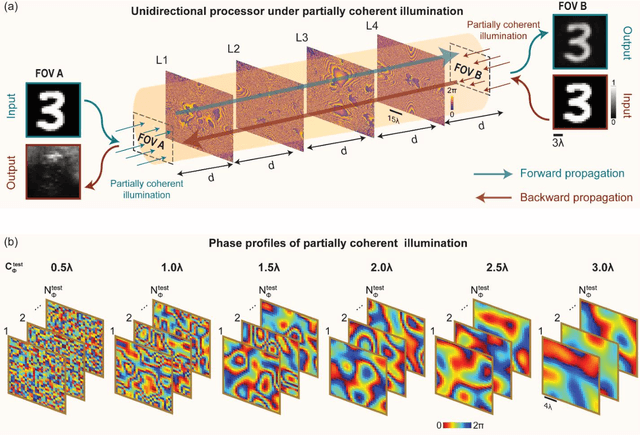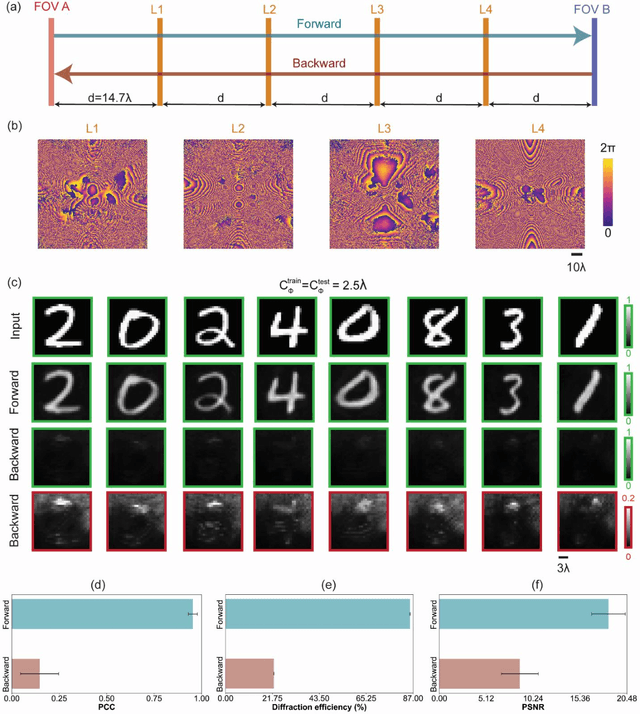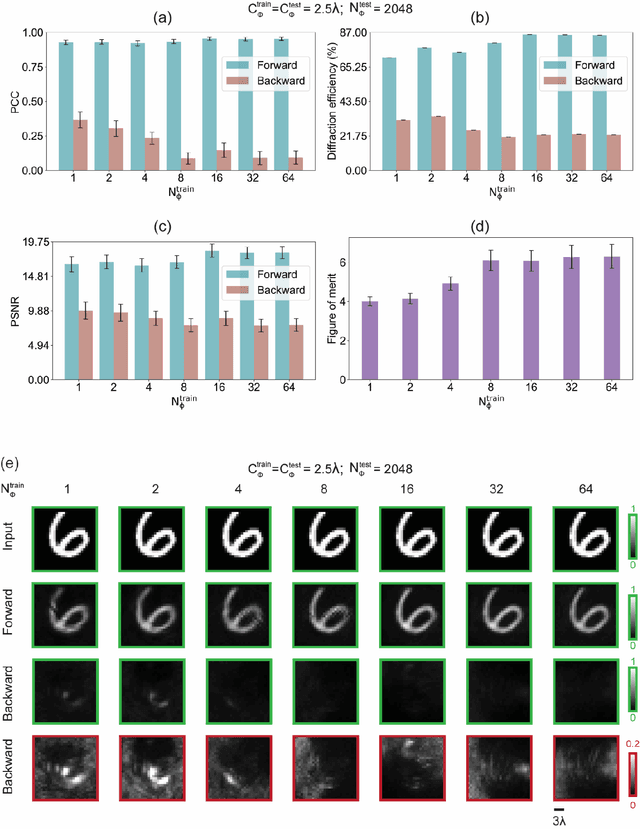Che-Yung Shen
Snapshot 3D image projection using a diffractive decoder
Dec 23, 2025Abstract:3D image display is essential for next-generation volumetric imaging; however, dense depth multiplexing for 3D image projection remains challenging because diffraction-induced cross-talk rapidly increases as the axial image planes get closer. Here, we introduce a 3D display system comprising a digital encoder and a diffractive optical decoder, which simultaneously projects different images onto multiple target axial planes with high axial resolution. By leveraging multi-layer diffractive wavefront decoding and deep learning-based end-to-end optimization, the system achieves high-fidelity depth-resolved 3D image projection in a snapshot, enabling axial plane separations on the order of a wavelength. The digital encoder leverages a Fourier encoder network to capture multi-scale spatial and frequency-domain features from input images, integrates axial position encoding, and generates a unified phase representation that simultaneously encodes all images to be axially projected in a single snapshot through a jointly-optimized diffractive decoder. We characterized the impact of diffractive decoder depth, output diffraction efficiency, spatial light modulator resolution, and axial encoding density, revealing trade-offs that govern axial separation and 3D image projection quality. We further demonstrated the capability to display volumetric images containing 28 axial slices, as well as the ability to dynamically reconfigure the axial locations of the image planes, performed on demand. Finally, we experimentally validated the presented approach, demonstrating close agreement between the measured results and the target images. These results establish the diffractive 3D display system as a compact and scalable framework for depth-resolved snapshot 3D image projection, with potential applications in holographic displays, AR/VR interfaces, and volumetric optical computing.
Unidirectional imaging with partially coherent light
Aug 10, 2024



Abstract:Unidirectional imagers form images of input objects only in one direction, e.g., from field-of-view (FOV) A to FOV B, while blocking the image formation in the reverse direction, from FOV B to FOV A. Here, we report unidirectional imaging under spatially partially coherent light and demonstrate high-quality imaging only in the forward direction (A->B) with high power efficiency while distorting the image formation in the backward direction (B->A) along with low power efficiency. Our reciprocal design features a set of spatially engineered linear diffractive layers that are statistically optimized for partially coherent illumination with a given phase correlation length. Our analyses reveal that when illuminated by a partially coherent beam with a correlation length of ~1.5 w or larger, where w is the wavelength of light, diffractive unidirectional imagers achieve robust performance, exhibiting asymmetric imaging performance between the forward and backward directions - as desired. A partially coherent unidirectional imager designed with a smaller correlation length of less than 1.5 w still supports unidirectional image transmission, but with a reduced figure of merit. These partially coherent diffractive unidirectional imagers are compact (axially spanning less than 75 w), polarization-independent, and compatible with various types of illumination sources, making them well-suited for applications in asymmetric visual information processing and communication.
Multiplane Quantitative Phase Imaging Using a Wavelength-Multiplexed Diffractive Optical Processor
Mar 16, 2024Abstract:Quantitative phase imaging (QPI) is a label-free technique that provides optical path length information for transparent specimens, finding utility in biology, materials science, and engineering. Here, we present quantitative phase imaging of a 3D stack of phase-only objects using a wavelength-multiplexed diffractive optical processor. Utilizing multiple spatially engineered diffractive layers trained through deep learning, this diffractive processor can transform the phase distributions of multiple 2D objects at various axial positions into intensity patterns, each encoded at a unique wavelength channel. These wavelength-multiplexed patterns are projected onto a single field-of-view (FOV) at the output plane of the diffractive processor, enabling the capture of quantitative phase distributions of input objects located at different axial planes using an intensity-only image sensor. Based on numerical simulations, we show that our diffractive processor could simultaneously achieve all-optical quantitative phase imaging across several distinct axial planes at the input by scanning the illumination wavelength. A proof-of-concept experiment with a 3D-fabricated diffractive processor further validated our approach, showcasing successful imaging of two distinct phase objects at different axial positions by scanning the illumination wavelength in the terahertz spectrum. Diffractive network-based multiplane QPI designs can open up new avenues for compact on-chip phase imaging and sensing devices.
Multiplexed all-optical permutation operations using a reconfigurable diffractive optical network
Feb 04, 2024



Abstract:Large-scale and high-dimensional permutation operations are important for various applications in e.g., telecommunications and encryption. Here, we demonstrate the use of all-optical diffractive computing to execute a set of high-dimensional permutation operations between an input and output field-of-view through layer rotations in a diffractive optical network. In this reconfigurable multiplexed material designed by deep learning, every diffractive layer has four orientations: 0, 90, 180, and 270 degrees. Each unique combination of these rotatable layers represents a distinct rotation state of the diffractive design tailored for a specific permutation operation. Therefore, a K-layer rotatable diffractive material is capable of all-optically performing up to 4^K independent permutation operations. The original input information can be decrypted by applying the specific inverse permutation matrix to output patterns, while applying other inverse operations will lead to loss of information. We demonstrated the feasibility of this reconfigurable multiplexed diffractive design by approximating 256 randomly selected permutation matrices using K=4 rotatable diffractive layers. We also experimentally validated this reconfigurable diffractive network using terahertz radiation and 3D-printed diffractive layers, providing a decent match to our numerical results. The presented rotation-multiplexed diffractive processor design is particularly useful due to its mechanical reconfigurability, offering multifunctional representation through a single fabrication process.
All-optical complex field imaging using diffractive processors
Jan 30, 2024Abstract:Complex field imaging, which captures both the amplitude and phase information of input optical fields or objects, can offer rich structural insights into samples, such as their absorption and refractive index distributions. However, conventional image sensors are intensity-based and inherently lack the capability to directly measure the phase distribution of a field. This limitation can be overcome using interferometric or holographic methods, often supplemented by iterative phase retrieval algorithms, leading to a considerable increase in hardware complexity and computational demand. Here, we present a complex field imager design that enables snapshot imaging of both the amplitude and quantitative phase information of input fields using an intensity-based sensor array without any digital processing. Our design utilizes successive deep learning-optimized diffractive surfaces that are structured to collectively modulate the input complex field, forming two independent imaging channels that perform amplitude-to-amplitude and phase-to-intensity transformations between the input and output planes within a compact optical design, axially spanning ~100 wavelengths. The intensity distributions of the output fields at these two channels on the sensor plane directly correspond to the amplitude and quantitative phase profiles of the input complex field, eliminating the need for any digital image reconstruction algorithms. We experimentally validated the efficacy of our complex field diffractive imager designs through 3D-printed prototypes operating at the terahertz spectrum, with the output amplitude and phase channel images closely aligning with our numerical simulations. We envision that this complex field imager will have various applications in security, biomedical imaging, sensing and material science, among others.
All-Optical Phase Conjugation Using Diffractive Wavefront Processing
Nov 08, 2023Abstract:Optical phase conjugation (OPC) is a nonlinear technique used for counteracting wavefront distortions, with various applications ranging from imaging to beam focusing. Here, we present the design of a diffractive wavefront processor to approximate all-optical phase conjugation operation for input fields with phase aberrations. Leveraging deep learning, a set of passive diffractive layers was optimized to all-optically process an arbitrary phase-aberrated coherent field from an input aperture, producing an output field with a phase distribution that is the conjugate of the input wave. We experimentally validated the efficacy of this wavefront processor by 3D fabricating diffractive layers trained using deep learning and performing OPC on phase distortions never seen by the diffractive processor during its training. Employing terahertz radiation, our physical diffractive processor successfully performed the OPC task through a shallow spatially-engineered volume that axially spans tens of wavelengths. In addition to this transmissive OPC configuration, we also created a diffractive phase-conjugate mirror by combining deep learning-optimized diffractive layers with a standard mirror. Given its compact, passive and scalable nature, our diffractive wavefront processor can be used for diverse OPC-related applications, e.g., turbidity suppression and aberration correction, and is also adaptable to different parts of the electromagnetic spectrum, especially those where cost-effective wavefront engineering solutions do not exist.
Multispectral Quantitative Phase Imaging Using a Diffractive Optical Network
Aug 05, 2023Abstract:As a label-free imaging technique, quantitative phase imaging (QPI) provides optical path length information of transparent specimens for various applications in biology, materials science, and engineering. Multispectral QPI measures quantitative phase information across multiple spectral bands, permitting the examination of wavelength-specific phase and dispersion characteristics of samples. Here, we present the design of a diffractive processor that can all-optically perform multispectral quantitative phase imaging of transparent phase-only objects in a snapshot. Our design utilizes spatially engineered diffractive layers, optimized through deep learning, to encode the phase profile of the input object at a predetermined set of wavelengths into spatial intensity variations at the output plane, allowing multispectral QPI using a monochrome focal plane array. Through numerical simulations, we demonstrate diffractive multispectral processors to simultaneously perform quantitative phase imaging at 9 and 16 target spectral bands in the visible spectrum. These diffractive multispectral processors maintain uniform performance across all the wavelength channels, revealing a decent QPI performance at each target wavelength. The generalization of these diffractive processor designs is validated through numerical tests on unseen objects, including thin Pap smear images. Due to its all-optical processing capability using passive dielectric diffractive materials, this diffractive multispectral QPI processor offers a compact and power-efficient solution for high-throughput quantitative phase microscopy and spectroscopy. This framework can operate at different parts of the electromagnetic spectrum and be used for a wide range of phase imaging and sensing applications.
Unidirectional Imaging using Deep Learning-Designed Materials
Dec 05, 2022Abstract:A unidirectional imager would only permit image formation along one direction, from an input field-of-view (FOV) A to an output FOV B, and in the reverse path, the image formation would be blocked. Here, we report the first demonstration of unidirectional imagers, presenting polarization-insensitive and broadband unidirectional imaging based on successive diffractive layers that are linear and isotropic. These diffractive layers are optimized using deep learning and consist of hundreds of thousands of diffractive phase features, which collectively modulate the incoming fields and project an intensity image of the input onto an output FOV, while blocking the image formation in the reverse direction. After their deep learning-based training, the resulting diffractive layers are fabricated to form a unidirectional imager. As a reciprocal device, the diffractive unidirectional imager has asymmetric mode processing capabilities in the forward and backward directions, where the optical modes from B to A are selectively guided/scattered to miss the output FOV, whereas for the forward direction such modal losses are minimized, yielding an ideal imaging system between the input and output FOVs. Although trained using monochromatic illumination, the diffractive unidirectional imager maintains its functionality over a large spectral band and works under broadband illumination. We experimentally validated this unidirectional imager using terahertz radiation, very well matching our numerical results. Using the same deep learning-based design strategy, we also created a wavelength-selective unidirectional imager, where two unidirectional imaging operations, in reverse directions, are multiplexed through different illumination wavelengths. Diffractive unidirectional imaging using structured materials will have numerous applications in e.g., security, defense, telecommunications and privacy protection.
 Add to Chrome
Add to Chrome Add to Firefox
Add to Firefox Add to Edge
Add to Edge